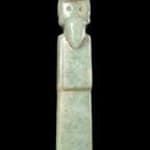Guanacaste-Nicoya Jade Bird-Celt Pendant, 1 CE - 500 CE
Jade
7.75
PF.3618
In the context of Pre-Columbian art and archaeology, jade is a generic term that refers to any variety of hard, dense stones that were worked with great skill by native...
In the context of Pre-Columbian art and archaeology, jade is a generic term that refers to any variety of hard, dense stones that were worked with great skill by native artists. Although jade is generally thought to be green, it can actually be a range of colors. Jade carving flourished in ancient Costa Rica for over a thousand years, roughly from 500 B.C. to 900 A.D., although the period of greatest artistic accomplishment lasted from 300 to 700 A.D. It is believed that jade working began during an extended period of agricultural abundance that allowed the ancient society to dedicate part of its energies toward the cultivation of artistic pursuits.
Jade was considered to be a sacred material by the ancient populations of Costa Rica, held in even higher esteem than gold. Generally, it was thought to symbolize that vital life force that sustains us all. The color green is naturally associated with verdant plant life. Specifically, jade was thought to symbolize the sprouting maize plant, that staple of the Pre-Columbian diet. It has also been suggested that jade represents water. Either way, we can be certain that jade represented the very essence of life itself.
To date, no native sources of jade have been discovered in Costa Rica, suggesting an extended trade network existed that imported this precious resource from Mesoamerica into Costa Rica where it was carved by local artists. Such trade also would have brought great wealth and likely reinforced the social stratification of the peoples. Jade may have served as a status marker to distinguish the elite from the masses and solidify their hold on power. We can picture an ancient ruler or shaman presiding over a sacred ceremonial adorned in brilliant green jade pendants and jewelry. The ancient Costa Ricans believe that the system of social hierarchy also extended into the afterlife. Therefore, jade objects were buried with the elite so that their power could be maintained throughout eternity.
This fascinating jade bird-celt pendant is carved of jade, a rare and beautiful stone that is much harder than obsidian. Jade is the toughest and most durable of the stones, and the flaking and chipping procedures that are effective on flint and other quartz minerals cannot work it. Its superiority, thus, could have become evident only at the Neolithic level of technology, when stone could be worked by abrasion. This jade bird-celt pendant is an animal, human or composite effigy surmounted on an axe-like polished blade. Such objects were drilled for suspension. This bird-celt effigy most likely depicts a quetzal. In Costa Rica, jade figure-celt pendants were symbolic, high-status objects that were valued greatly. Owners of such pendants were influential in decisions involving land use or redistribution of foodstuffs. Such effigies were also important in rituals, or they may have been clan symbols. Possessing a graceful poignancy, this long, vertical pendant is beautifully sculpted. The headdress mounted on the avian head is most likely indicative of the pendant owner's status. A precious artwork from the ancient world, this jade pendant brings us the rich history and symbolism buried in time.
Jade was considered to be a sacred material by the ancient populations of Costa Rica, held in even higher esteem than gold. Generally, it was thought to symbolize that vital life force that sustains us all. The color green is naturally associated with verdant plant life. Specifically, jade was thought to symbolize the sprouting maize plant, that staple of the Pre-Columbian diet. It has also been suggested that jade represents water. Either way, we can be certain that jade represented the very essence of life itself.
To date, no native sources of jade have been discovered in Costa Rica, suggesting an extended trade network existed that imported this precious resource from Mesoamerica into Costa Rica where it was carved by local artists. Such trade also would have brought great wealth and likely reinforced the social stratification of the peoples. Jade may have served as a status marker to distinguish the elite from the masses and solidify their hold on power. We can picture an ancient ruler or shaman presiding over a sacred ceremonial adorned in brilliant green jade pendants and jewelry. The ancient Costa Ricans believe that the system of social hierarchy also extended into the afterlife. Therefore, jade objects were buried with the elite so that their power could be maintained throughout eternity.
This fascinating jade bird-celt pendant is carved of jade, a rare and beautiful stone that is much harder than obsidian. Jade is the toughest and most durable of the stones, and the flaking and chipping procedures that are effective on flint and other quartz minerals cannot work it. Its superiority, thus, could have become evident only at the Neolithic level of technology, when stone could be worked by abrasion. This jade bird-celt pendant is an animal, human or composite effigy surmounted on an axe-like polished blade. Such objects were drilled for suspension. This bird-celt effigy most likely depicts a quetzal. In Costa Rica, jade figure-celt pendants were symbolic, high-status objects that were valued greatly. Owners of such pendants were influential in decisions involving land use or redistribution of foodstuffs. Such effigies were also important in rituals, or they may have been clan symbols. Possessing a graceful poignancy, this long, vertical pendant is beautifully sculpted. The headdress mounted on the avian head is most likely indicative of the pendant owner's status. A precious artwork from the ancient world, this jade pendant brings us the rich history and symbolism buried in time.



